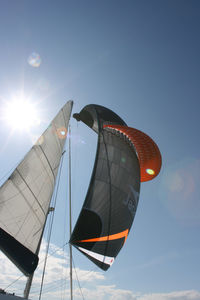
Issue #: 176
Published: March / April 2021
- Price per issue - digital : 6.50€Digital magazine
- Price per issue - print : 8.50€Print magazine
- Access to Multihulls World digital archives Digital archives
On a multihull, a symmetrical spinnaker does not need to be flown from a spinnaker pole. This downwind sail is very well suited for cruising catamarans which have a large beam for rigging the tacking points of the sheets and guys on each hull. An ideal sail for multihulls that sailing almost downwind on a tradewind route. Two solutions exist: the classic spinnaker or the famous Parasailor. Which one should you choose?

FOR THE PARASAILOR SPINNAKER - by Annie Bernard
Since 2012, Annie has been the importer for France of Parasailor spinnakers. Designed by Istec, the world’s leading paraglider manufacturer, this atypical sail was developed using aeronautical technology. Annie explains all the advantages to us.

“For the last ten years, you have surely noticed (perhaps with surprise) a type of wing flying over the water. The openings and the floating wing on the upper surface give the Parasailor an easily identifiable look. This sail, which first appeared in 2009, has earned a reputation as a symmetrical spinnaker whose shape is maintained thanks to its integrated wing. It is first and foremost a cruising sail for short-handed crews that favors safety thanks to its great stability. Its qualities enabled the crew of a Fountaine-Pajot Salina 48 to win the 2015 edition of the ARC ahead of 0utremers and Neel 45s, which are much more efficient on paper. The opening acts as a valve in the gusts, relieving the canopy of pressure and the wing prevents the luff as well as the leech from stalling too easily. These features allowed our test crew to keep the spinnaker up 90% of the time spent under sailing, beating the speed record of the catamaran, at more than 24 knots. For this occasion, the spinnaker was oversized to be carried longer and thus boost performance. With its standard size of 1,830 sq ft (170 m²) for a 47-footer, the risk of the sail blowing out is almost non-existent, even with thirty-knot gusts. In ten years of operation, we have had no severe breakages. The fabric, a double rip-stop nylon with a weight of 44 gr/m² (approx. 1 oz US sailcloth weight) up to 2,370 sq ft (220 m²) in size and 70 - 75 gr/m² (approx. 1½oz) above that area, is of aeronautical quality. On the latest models, the sheeting points have been reinforced. With the opening reducing tension and keeping the spinnaker up, there is lift at the leeward hull, significantly reducing the risk of burying the bows. Depending on the intended use, it is possible to choose a leech length of more or less one meter (3 feet) between the halyard point and deck level. Most customers have opted for quiet and comfortable sailing with a small size, but the new generation is optimized to work also in very light airs, from two to three knots. The wing size has been reduced, making it easier to hoist and douse, using the Easysnuffer sock. Its shape, more cambered with valve flaps, ensures greater responsiveness thanks to a smoother flow of air particles. This new generation allows upwind angles up to 70° off the apparent wind and downwind up to 180°. The range of use is therefore very wide. As this sail corrects small deviations by re-inflating without having to intervene on the sheets, the autopilot can be used for long periods, and if it is set on wind mode, you may not have to intervene at all on long tacks.”
FOR THE TRADITIONAL SPINNAKER - by Bernard Mallaret

Bernard is the general manager of ...
What readers think
Post a comment
No comments to show.